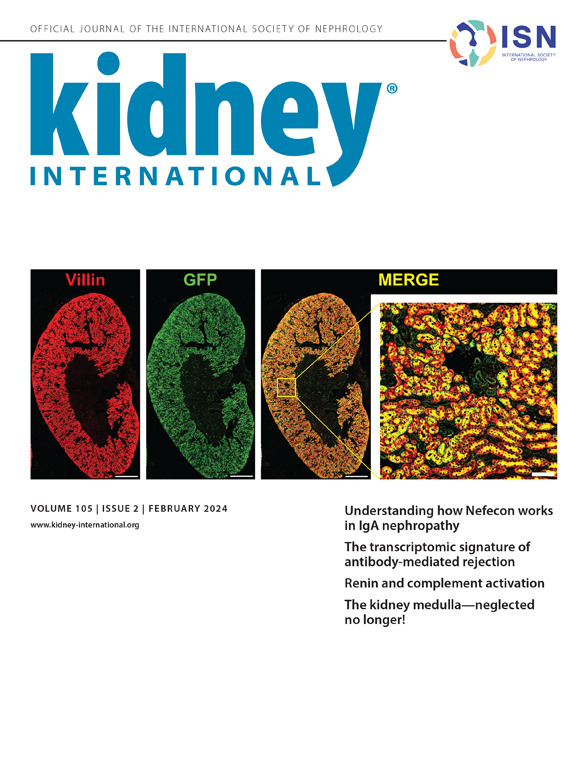狼疮性肾炎:重新定义治疗目标
IF 14.8
1区 医学
Q1 UROLOGY & NEPHROLOGY
引用次数: 0
摘要
增殖性狼疮肾炎(LN)的病程特点是,在慢性免疫失调的背景下,活动期与静止期交替出现。准确评估疾病的活动性对于调整治疗方案具有无可置疑的重要性。在这篇通讯中,我们讨论了可用来评估疾病活动性的临床、血清学和组织学工具,以及如何应用这些工具重新定义 LN 的治疗目标。传统上,治疗反应是通过蛋白尿减少和肾功能改善的程度来判断的,但这无法区分持续的炎症性疾病和慢性损伤。尽管进行了大量研究,但没有任何新型生物标志物被证明对临床实践有用,我们仍然依靠抗双链 DNA 抗体水平(anti-dsDNA)来评估血清学活性。尽管临床症状明显缓解,但重复肾脏活检有时会发现炎症持续存在,这使人们相信组织学缓解应成为治疗目标,并将方案活检作为决策过程的一部分。然而,临床和组织学治疗反应之间的差异可以解释为持续的系统性自身免疫和低水平的免疫复合物沉积,或者解释为免疫缓解后肾内炎症的延迟清除。由于持续性免疫失调是 LN 疾病活动的驱动因素,因此应将其作为治疗和监测的主要重点。我们建议用一种更动态、更个性化的方法取代传统的诱导-缓解维持方案,并同时而非依次实现三个治疗目标:1)临床缓解:以镜下血尿、蛋白尿、eGFR 和补体水平为生物标志物,减轻肾脏炎症;2)免疫缓解:以抗dsDNA 为生物标志物,减少免疫复合物的产生;3)肾功能保护:以 eGFR 斜率为生物标志物,减少慢性肾损伤。本文章由计算机程序翻译,如有差异,请以英文原文为准。
Lupus nephritis: redefining the treatment goals
The course of proliferative lupus nephritis is characterized by flares of activity alternating with periods of quiescence against a background of chronic immune dysregulation. An accurate assessment of disease activity is of unassailable importance to tailor therapy. In the present communication, we discuss the available clinical, serologic, and histologic tools to evaluate disease activity and how they may be applied to redefine the treatment goals in lupus nephritis. Traditionally, treatment response is judged by the degree of proteinuria reduction and improvement of kidney function, but this fails to differentiate ongoing inflammatory disease from chronic damage. Despite intensive research, no novel biomarker has proved useful for clinical practice, and we continue to rely on anti–double-stranded DNA antibody levels to assess serologic activity. Repeat kidney biopsies sometimes reveal persistent inflammation despite apparent clinical remission, giving credibility to the conviction that histologic remission should be a treatment goal and protocol biopsies be part of the decision-making process. However, the discrepancies between clinical and histologic responses to therapy can be explained by persistent systemic autoimmunity with low-grade immune complex deposition or, alternatively, by delayed clearance of intrarenal inflammation once immunologic remission has been achieved. Because persistent immune dysregulation is the motor of disease activity in lupus nephritis, it should be the principal focus of therapy and monitoring. We propose to replace the traditional induction-remission maintenance protocol by a more dynamic and individualized approach and aim for 3 treatment goals, concomitantly rather than sequentially: (i) clinical remission, by attenuating renal inflammation, using microscopic hematuria, proteinuria, estimated glomerular filtration rate, and complement levels as biomarkers; (ii) immunologic remission, by decreasing immune complex generation, using anti–double-stranded DNA antibody as a biomarker; and (iii) preservation of kidney function, by curtailing chronic kidney damage, using estimated glomerular filtration rate slope as a biomarker.
求助全文
通过发布文献求助,成功后即可免费获取论文全文。
去求助
来源期刊

Kidney international
医学-泌尿学与肾脏学
CiteScore
23.30
自引率
3.10%
发文量
490
审稿时长
3-6 weeks
期刊介绍:
Kidney International (KI), the official journal of the International Society of Nephrology, is led by Dr. Pierre Ronco (Paris, France) and stands as one of nephrology's most cited and esteemed publications worldwide.
KI provides exceptional benefits for both readers and authors, featuring highly cited original articles, focused reviews, cutting-edge imaging techniques, and lively discussions on controversial topics.
The journal is dedicated to kidney research, serving researchers, clinical investigators, and practicing nephrologists.
 求助内容:
求助内容: 应助结果提醒方式:
应助结果提醒方式:


